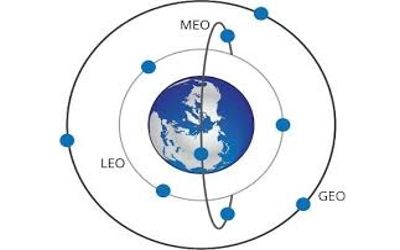Medium Earth orbit (MEO) is the region of space around the Earth above low Earth orbit and below the geostationary orbit. It is sometimes called intermediate circular orbit (ICO), is the region of space around Earth above low Earth orbit (altitude of 2,000 km (1,243 mi) above sea level) and below geosynchronous orbit (altitude of 35,786 km (22,236 mi) above sea level). The most common use for satellites in this region is for navigation, such as the GPS (with an altitude of 20,200 kilometers), Glonass (with an altitude of 19,100· kilometers), and Galileo (with an altitude of 23,222· kilometers) constellations.
The region of space in between the low Earth orbit and the geostationary orbit is called the Medium Earth Orbit (MEO). This orbit is at a distance of 2000 to 35786 km from the earth’s surface.
The orbit is home to a number of artificial satellites – the most common uses include navigation, communication, and geodetic/space environment science. Communications satellites that cover the North and South Pole are also put in MEO. The most common altitude is approximately 20,200 kilometers (12,552 mi), which yields an orbital period of 12 hours, as used, for example, by the Global Positioning System (GPS). The orbital·periods of MEO satellites range from about 2 to 24 hours. Telstar, one of the first and most famous experimental satellites, orbits in MEO.

Closer to the Earth, satellites in a medium Earth orbit move more quickly. Other satellites in medium Earth orbit include Glonass (with an altitude of 19,100 kilometers (11,900 mi)) and Galileo (with an altitude of 23,222 kilometers (14,429 mi)) constellations. Two medium Earth orbits are notable: the semi-synchronous orbit and the Molniya orbit. The semi-synchronous orbit is a near-circular orbit 26,560 kilometers from the center of the Earth (about 20,200 kilometers above the surface). The second common medium Earth orbit is the Molniya orbit. Invented by the Russians, the Molniya orbit works well for observing high latitudes.
Communications satellites in MEO include the O3b and forthcoming O3b mPOWER constellations for telecommunications and data backhaul to maritime, aero, and remote locations (with an altitude of 8,063 kilometers (5,010 mi)). Some examples of satellites that operate from this orbit include GPS (Altitude of 20,200 kilometers), GLONASS (Altitude of 19,100 kilometers), and Galileo (Altitude of 23,222 kilometers). Communications satellites that cover the North and South Pole are also put in MEO. The MEO satellites have an orbital period ranging from 2 to 24 hours. Telstar, the first experimental satellite launched in 1962, also orbits in MEO.
Information Source:
















